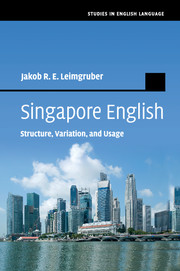Book contents
- Frontmatter
- Dedication
- Contents
- List of figures
- List of tables
- Acknowledgements
- List of abbreviations, glosses, and symbols
- 1 Introduction: Singapore and its Englishes
- 2 Variation in Singapore English: old and new models
- 3 Description: phonology and lexicon
- 4 Description: grammar
- 5 Indexicality: a model for Singapore?
- 6 Conclusion: the variety as a structural unit
- Appendix A Chinese romanisation
- Appendix B Informants
- Appendix C Chinese languages
- References
- Author index
- Subject index
2 - Variation in Singapore English: old and new models
Published online by Cambridge University Press: 05 July 2013
- Frontmatter
- Dedication
- Contents
- List of figures
- List of tables
- Acknowledgements
- List of abbreviations, glosses, and symbols
- 1 Introduction: Singapore and its Englishes
- 2 Variation in Singapore English: old and new models
- 3 Description: phonology and lexicon
- 4 Description: grammar
- 5 Indexicality: a model for Singapore?
- 6 Conclusion: the variety as a structural unit
- Appendix A Chinese romanisation
- Appendix B Informants
- Appendix C Chinese languages
- References
- Author index
- Subject index
Summary
Early models and diglossia
The continuum hypothesis
In his seminal 1975 article, John T. Platt introduces two important concepts into the way in which SgE is viewed. Firstly, he applies the concept of a post-creole continuum, championed by DeCamp (1971), to the SgE speech community. His is a much more dynamic model than Ferguson and Stewart's formulae. Secondly, he introduces the term creoloid to describe a particular type of contact variety. I will first examine the concept of the post-creole continuum, before explaining the reasons for Platt's choice of the term creoloid.
The Jamaican continuum
Much of Platt's inspiration for the post-creole continuum analysis comes from DeCamp's work on Jamaican English, which considers ‘post-creoles’, i.e. creoles that ‘gradually merge with the corresponding standard language [that is, their lexifier]’ (1971: 349). This is not always the case; similar situations may result in quite different outcomes: Haitian Creole French, for instance, has continued co-existing with Standard French in a diglossic situation without any sign of merger (Ferguson 1959; DeCamp 1971: 351). DeCamp (1971: 350) defines a post-creole situation as one where he says there is ‘no sharp cleavage between creole and standard’. Rather, ‘there is a linguistic continuum, a continuous spectrum of speech varieties ranging from … “bush talk” or “broken language” … to the educated standard’ (De-Camp 1971: 350). This continuum, made up of its extremes, the basilect and the acrolect, and the intervening mesolects, presents a seamless succession of subvarieties: it is in fact so fine-grained that it cannot be subdivided into discrete lects.
- Type
- Chapter
- Information
- Singapore EnglishStructure, Variation, and Usage, pp. 26 - 63Publisher: Cambridge University PressPrint publication year: 2013

